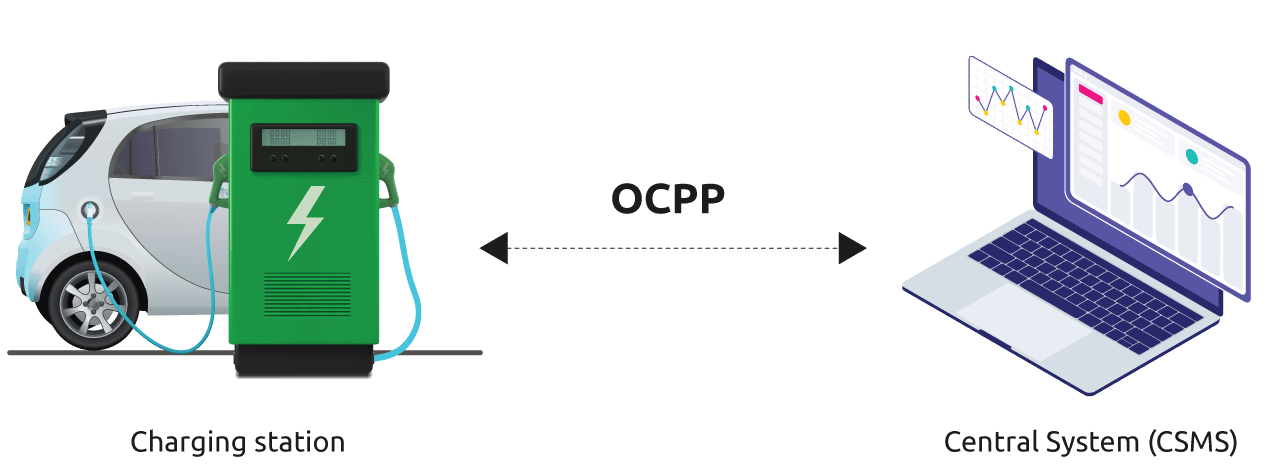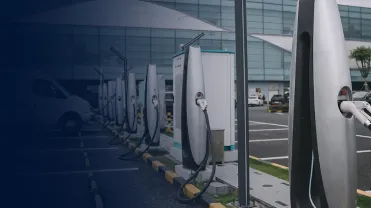OCPP explained: Driving interoperability
in EV charging networks
Imagine if every mobile phone needed a custom network to make a call — Apple phones could only talk to Apple towers, Samsung to Samsung. No shared language, no interoperability. Chaos, right? That’s exactly the problem OCPP solves in the world of EV charging.
The reality of electric vehicle (EV) charging not too long ago was similar – with each charging point operating on its own proprietary protocol, integration was complex, costly, and difficult to scale.
Enter the Open Charge Point Protocol (OCPP).
OCPP is an open communication standard that allows EV charging stations (Charge Points) to talk to Charging Station Management Systems (CSMS) seamlessly. This standardisation means an EV charger from one manufacturer can be managed by software from another, preventing vendor lock-in and offering Charge Point Operators (CPOs) enhanced flexibility and interoperability while ensuring a consistent and hassle-free experience for EV drivers.
How does OCPP protocol work
OCPP enables smooth, two-way communication between an EV charger and the central system that manages it. Here’s how the ecosystem comes together:
- Charge Point (Charger): The physical hardware that communicates key information such as availability status, energy consumption metrics, and user interactions (e.g., plugging in, starting a session). It also receives and executes commands from the CSMS.
- Central System (CSMS): This is the backend software that manages one or more chargers. It issues commands such as starting or stopping a session, pushing configuration updates, or delivering over-the-air firmware upgrades to the Charge Points.
- Communication Channels: OCPP messages are typically exchanged over secure internet-based protocols like WebSocket or MQTT, forming a layered, secure, real-time messaging flow.

Why OCPP integration matters
Whether you’re a city deploying public chargers, an OEM building smart infrastructure, or a business investing in EV fleets, OCPP offers critical benefits:
- Interoperability: Enables seamless communication between OCPP compliant chargers and backend system, ensuring EV drivers enjoy a consistent charging experience everywhere.
- Flexibility: Avoids vendor lock-in by allowing you to mix and match hardware and software based on evolving needs.
- Scalability: Supports easy expansion — ideal for organizations growing from pilot installations to full-scale deployments.
- Security: Implements modern encryption and user authentication, meeting the critical security needs of cities, utilities, and infrastructure providers.
The evolution of OCPP
OCPP has evolved through several versions, with OCPP 1.6 being widely adopted, and OCPP 2.0.1 introducing advanced features like device management, improved security, and support for smart charging. Each new version continues to improve compatibility, functionality, and performance — keeping pace with the growing demands of EV infrastructure.

OCPP: The API economy of EV infrastructure
As the global EV landscape rapidly expands, OCPP is emerging as one of the foundational layers powering EV infrastructure innovation and adoption. Real-world applications include:
- Fleet operators using OCPP to remotely schedule, monitor, and optimise charging cycles across distributed fleets.
- Grid operators implementing dynamic pricing and demand response mechanisms to balance load and reduce peak stress.
- Charging service providers integrating billing, loyalty programs, and mobile apps for a seamless customer experience.
- Charge point operators leveraging real-time data to monitor charger status, vehicle parameters, and diagnostics, enabling remote configuration, updates, and resets via protocols like MQTT or AWS IoT Core.
- Energy managers deploying OCPP-based smart charging modules to create and assign dynamic load profiles by site, region, or utility zone, ensuring grid stability and preventing local overloads.
- EV OEMs and tech partners benefitting from easy integration with adjacent protocols, including:
- ISO 15118, which works alongside OCPP to enable features like Plug & Charge and two-way Vehicle-to-Grid (V2G) communication
- OpenADR, which integrates with OCPP systems to trigger automated demand response signals for load reduction during peak periods. Learn more about OpenADR.
In 2024, the International Electrotechnical Commission (IEC) officially approved OCPP 2.0.1 as an international standard, IEC 63584, solidifying OCPP’s role as the global benchmark for interoperable, secure EV charging communication.
Bridging OCPP with other protocols
The power of OCPP multiplies when it interfaces with other industry protocols. Here’s how some common integrations work:
- OCPP to MQTT: While OCPP 1.6 and 2.0.1 support WebSockets by default, MQTT is becoming a preferred transport for cloud-based, lightweight, and reliable EVSE communication. MQTT enhances OCPP-based systems with efficient message delivery in distributed environments, making it ideal for smart cities and fleet operations.
- OCPP to BACnet: As smart buildings adopt EV charging stations, there’s growing interest in integrating OCPP chargers with BACnet, the dominant building automation protocol. OCPP-to-BACnet converters or gateways enable real-time energy data exchange, helping facility managers optimise grid usage, HVAC sync, and load balancing.
- OCPP to Modbus: In industrial environments, Modbus still powers legacy systems. Bridging OCPP to Modbus allows for unified monitoring across EVSEs and other operational tech, often via protocol gateways or edge software that translates EV charger metrics into Modbus registers.
Softdel's strategic role
At Softdel, we’ve spent more than two decades building deep expertise in protocol engineering (BACnet, Modbus, Matter), edge connectivity, and IoT integration across smart buildings, energy, and industrial automation. That same depth now powers our OCPP offerings — where we treat the protocol not just as code, but as a critical infrastructure.
As a result, Softdel is uniquely positioned as the glue between EV charging, smart energy systems, and the wider IoT ecosystem, enabling seamless end-to-end energy optimisation, billing, building integration, and more.
Softdel delivers a secure, lightweight, embedded, OCPP-compliant stack with broad support for a diverse range of microcontrollers, integrated with AWS IoT Core for cloud connectivity. Built using our robust self-certified MicroOCPP library, the solution delivers:
- Secure, mutual TLS authentication for critical infrastructure
- Core OCPP messaging support (BootNotification, Heartbeat, StatusNotification, RemoteStartTransaction, etc.)
- Custom MQTT/WebSocket layer, on top of OCPP, to enable real-time cloud interaction via AWS IoT Core
- A compact, low-power design ideal for constrained embedded devices
The EV charging ecosystem is evolving from simple power delivery to intelligent energy orchestration, and OCPP is leading this transformation. With our experience in protocol integration and data-driven platforms, Softdel is ready to help EV OEMs, charge point operators, and energy utilities embrace the next wave of innovation.
Looking to implement or upgrade your OCPP-based infrastructure?
Get in touch with Softdel to build, scale, and optimise intelligent, interoperable EV charging solutions.
Let’s power the future — one OCPP-connected charge at a time.







